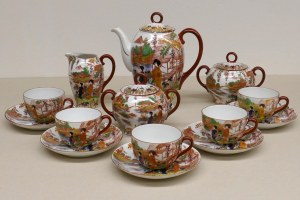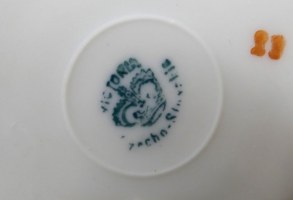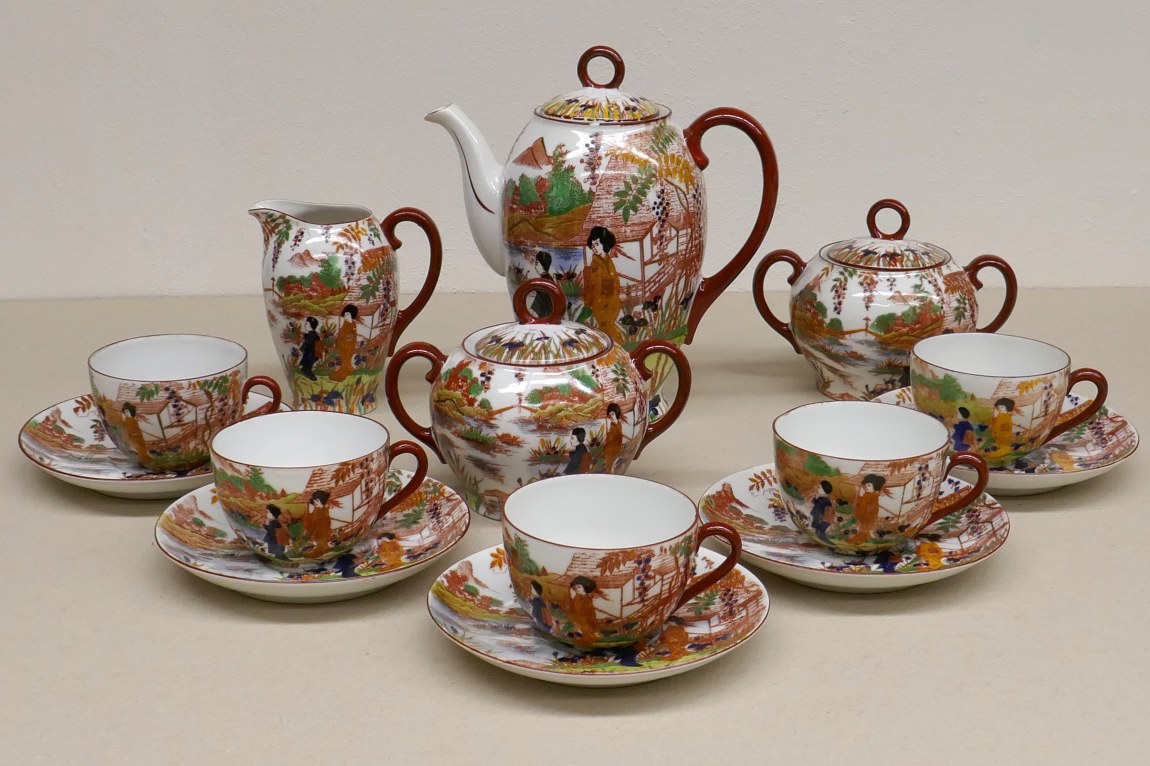Porcelain Coffee Set with Exotic Motif
› Detail › Porcelain Coffee Set with Exotic MotifExhibit of the Month 12/2024
The exhibit of December was selected with regard to the ongoing exhibition titled "From the Bridge to the End of the World," which presents the museum's collection of exotic items from all corners of the globe. Interest in exotic lands influenced the aesthetic sensibilities of Europeans at various times and was reflected in all forms of art and craftsmanship. The production of ceramics and porcelain in the Czech lands was no exception. Our displayed coffee set was manufactured at the Victoria A. G. factory in Stará Role, probably between 1918 and 1938. The collection service is not complete, containing a total of 9 pieces of porcelain goods. It consists of a large coffee pot, a small milk jug, two sugar bowls, and five cups with saucers. All are made of fine white porcelain, with the main decoration executed in the form of colorful transfers and complemented by hand painting; the handles and grips are adorned with a reddish-brown glaze. The central motif depicts a pair of female figures in traditional Japanese clothing – kimonos, in a romantic landscape with a pond, a bridge, a pavilion, and blue irises. The color palette of the decoration mimics traditional Japanese patterns.
Some pieces of porcelain are marked on the reverse side with the production mark "Viktoria Czecho – Slovakia," which is printed under the glaze in green or blue and supplemented with a numeral. Our exhibit of the month bears a mark whose main motif is a decorated crown with the top inscription Victoria and the lower inscription Czecho – Slovakia, which replaced the original inscription Austria. Throughout its existence, the factory used several types of production marks. The factory itself was founded in 1883 in Stará Role (Alt Rohlau – now a district of Karlovy Vary) and was registered as Porzellanfabrik Victoria Schmidt & Co., later known as Porzellanfabrik Victoria A. G. The factory was owned by the London firm Lazarus & Rosenfeld. The porcelain factory produced consumer goods for a wide clientele, as well as for demanding customers. In addition to inexpensive stoneware labeled as "Porelite," the factory produced a wide range of porcelain products. From white, completely undecorated porcelain, through hand-painted porcelain in vibrant colors, to porcelain products decorated with color prints. Besides very popular floral motifs, so-called "chinoiserie" and "japonerie" (fantastic, floral, animal, and decorative patterns, Chinese and Japanese landscape scenes with figurative staffage created according to European ideas in the 17th – 19th centuries) were also in demand. In the 1920s, the range was expanded to include the production of auxiliary materials (e.g., dyes). Due to competitiveness, the operation was modernized in the 1930s, and new technological processes were introduced. Promising development was halted with the outbreak of World War II, when the German Reich administration was installed in the company, and traditional production shifted to mass production of porcelain dishes for the needs of the German army (special markings were used for dishes for SS members – under the company designation "Victoria," the inscription "Waffen SS" was added). In 1944, operations were interrupted, and the premises were used for storing aircraft components.
After the war, the factory was nationalized, merged with another Stará Role porcelain factory "Royal Epiag," and then continued to operate within the n. p. Starorolský porcelain, Stará Role. In 1958, during the reorganization of the porcelain industry and the creation of the industry management Karlovarský porcelain, n. p., it was incorporated as the Stará Role II plant. Temporarily, electrical porcelain was produced here; after its production was relocated to Loun, the factory was closed. In 1970, the Stará Role II plant was converted into a vocational training facility.


Text and photo: Dagmar Pícová
 en
en cs
cs de
de